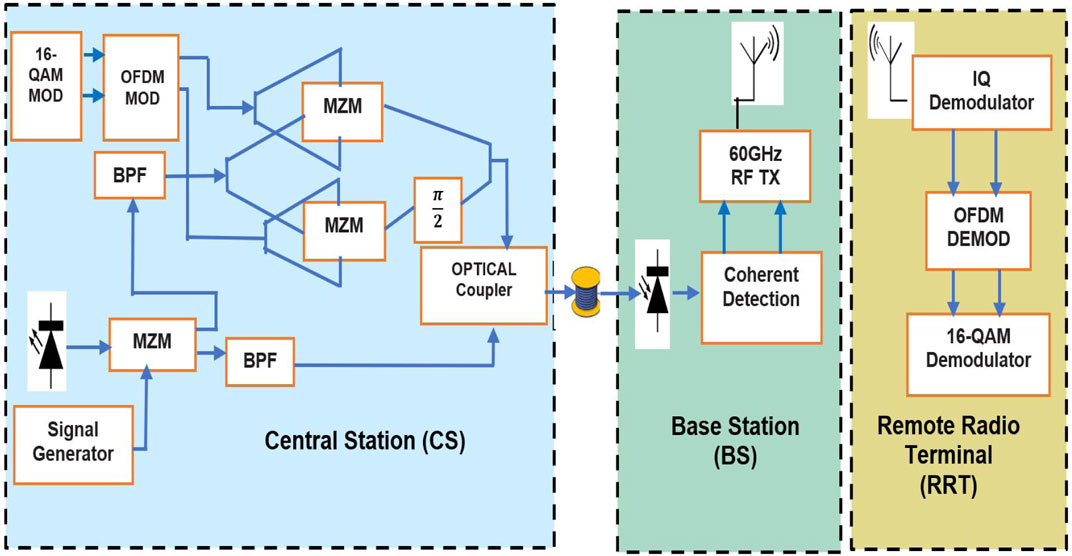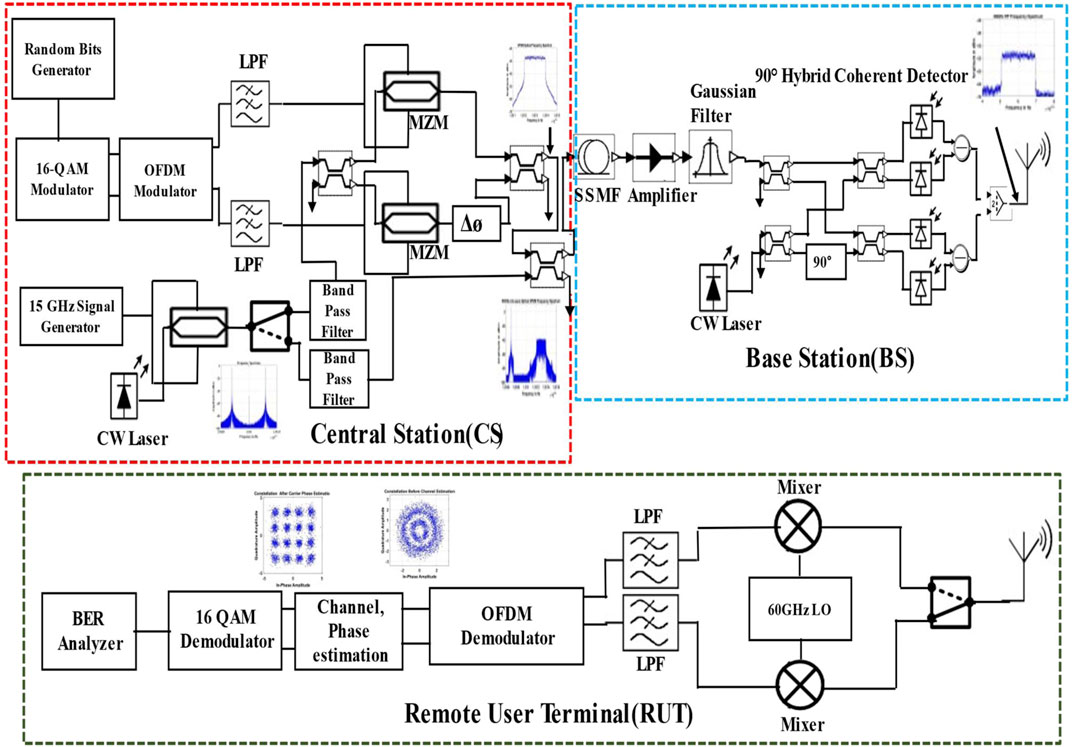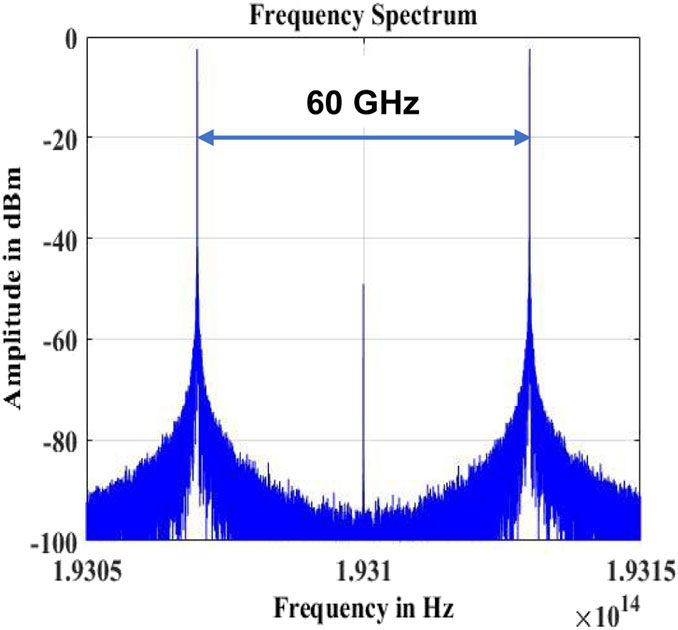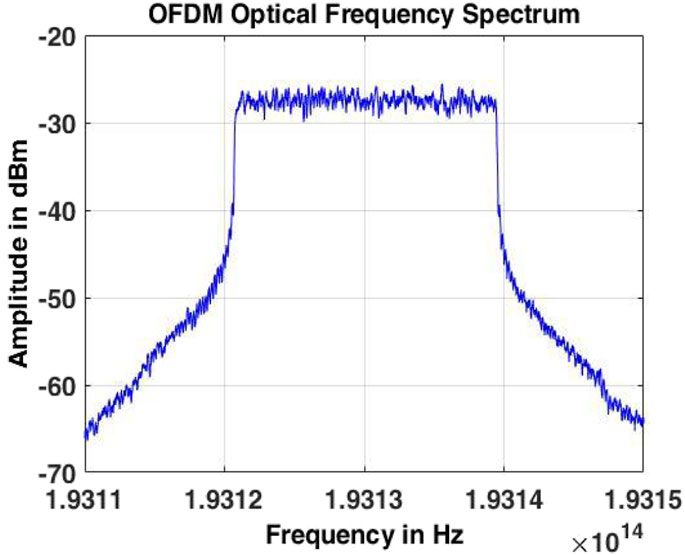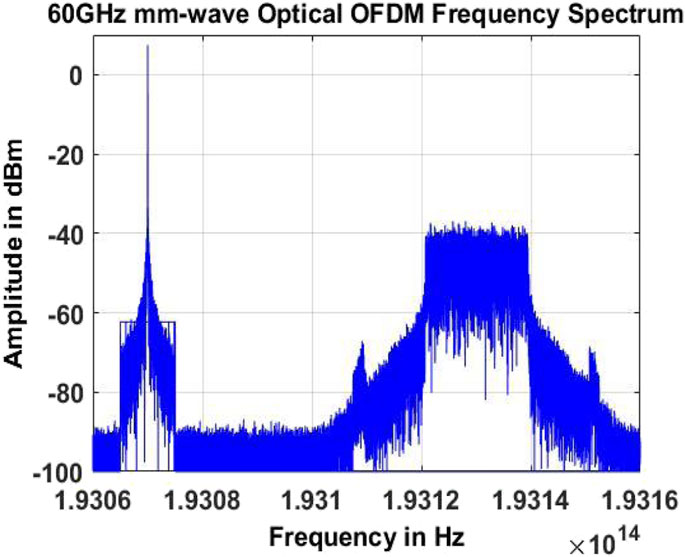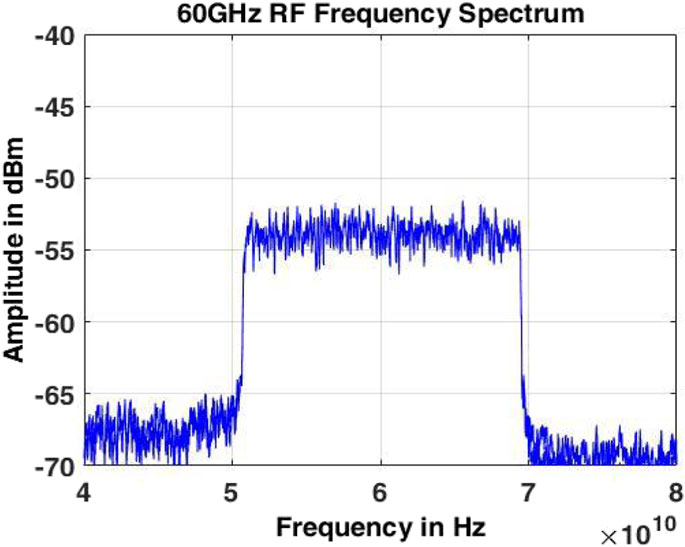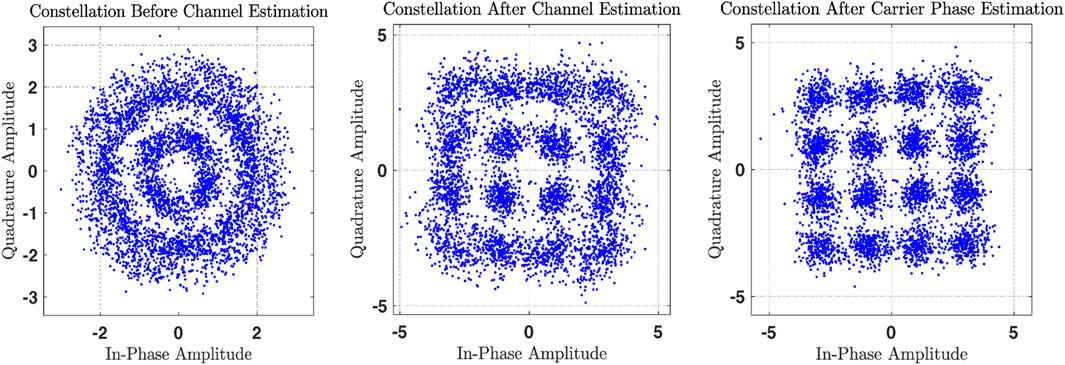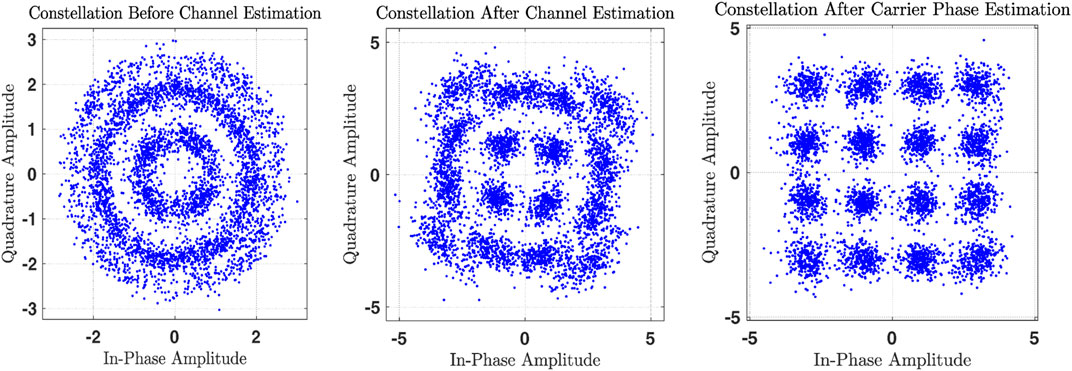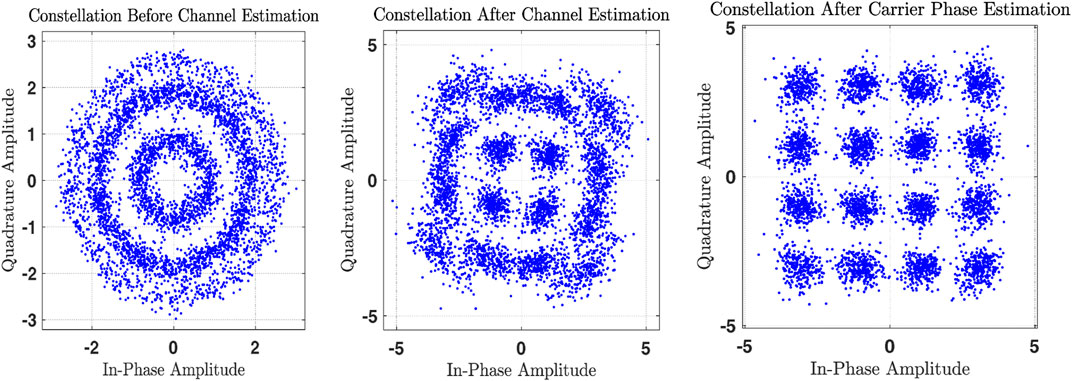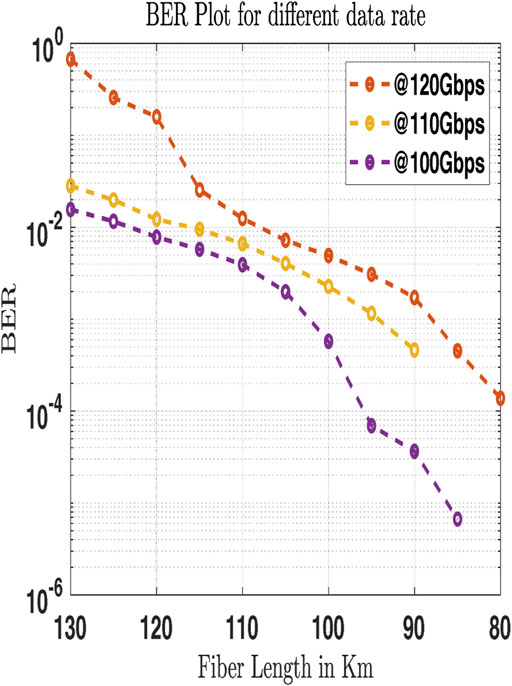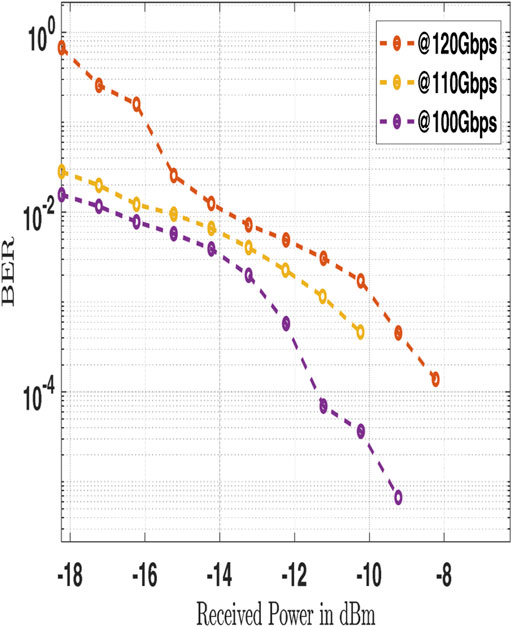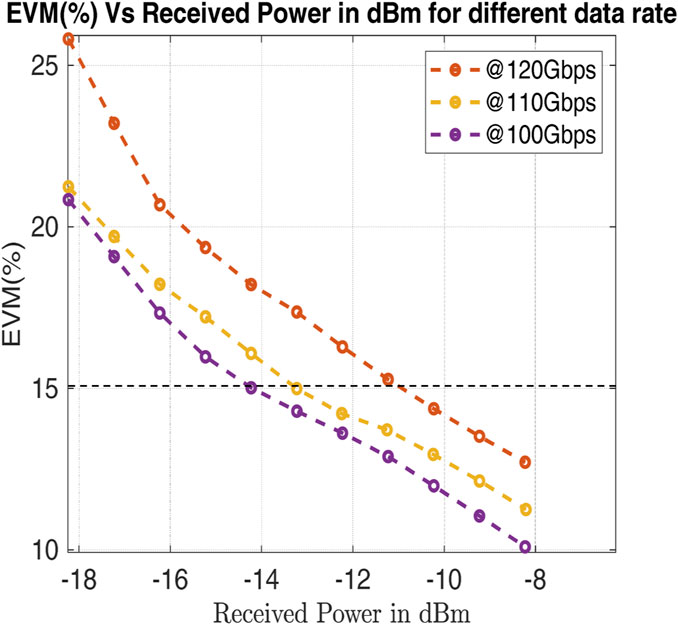- Department of Electronics Engineering, Indian Institute of Technology (ISM), Dhanbad, Jharkhand, India
The optical orthogonal frequency division multiplexing (OFDM) is proven to be a most promising technology for the next-generation high-capacity and ultra-wide bandwidth 5G communication systems. 60 GHz millimeter-wave (mm-wave) frequency band is also becoming a most popular upcoming frequency spectrum due to today’s available dense frequency spectrum used for mobile, multimedia, and data communication, etc. We propose a system comprised of 60 GHz radio-over-fiber (RoF) model using optimized optical frequency quadrupling, coherent detection, channel estimation, and carrier phase correction techniques for ultra-wide bandwidth 16-quadrature amplitude modulation (QAM) OFDM baseband signal. The proposed RoF system’s outcomes have shown relatively better bit error rate (BER) of 3.1 × 10–3 to enable successful transmission of 110 Gbps data for more than 105 km optical link comprising of standard single-mode fiber (SSMF). System performance and obtained results show a potential to fulfill the requirements of 5G and cellular communication system.
Introduction
The RoF has grown expressively and achieved good technical maturity in the past 3 decades. The research is focused on generating, transporting, and distributing radio signal in mm-wave band over optical fiber to meet the requirement of next-generation broadband 5G technology [1, 2]. In mm-wave, 60 GHz is the unlicensed spectrum which is becoming popular and would be a most promising band for 5G communication. Though it has disadvantage of huge propagation loss and caters for small distance communication, still it is found to be the most suitable wireless communication link ultra-wide bandwidth access. Inline to the above, it also shows the capability to fulfill the requirements of upcoming 5G network access [3]. OFDM-based RoF system has been widely studied and verified performance in terms of spectral signal purity and system robustness characteristics against optical fiber chromatic dispersion (CD), polarization mode dispersion (PMD), etc. [4–8]. Some of the studies represented the hybrid mm-wave RoF system optical OFDM signal transmission using various techniques such as POLMUX, double-lens scheme, and polarization multiplexing technique over 50 km over SSMF and 20 m wireless link [9, 10]. Performance of any RoF system mainly depends on the characteristics and design implementation of the elements used. These elements are laser source and its power level, optical modulator, optical fiber channel, and linear and nonlinear irregularities such as chromatic dispersion, PMD, bit rate/data rate, and modulation and demodulation scheme. In some studies, it is represented as OFDM transmission using M-ary QAM with in-phase (I) and quadrature (Q) modulator and transmitted carrier frequency ranging from 2.4–10 GHz over a SSMF achieved reasonable data rate transceiver performance. The observed BER and error vector magnitude (EVM) of such implementation scheme is quite good, but it is limited to very short range/distance [4, 6, 8, 13–15]. The M-ary QAM digital modulation and demodulation technique used in any optical OFDM system represents better spectral efficiency and achieved good BER for high-capacity data transmission as compared to the other modulation technique [11–18]. In addition to this, the robust performance of the optical transceiver is achieved against the SSMF linear and nonlinear effect of chromatic dispersion, PMD, using Mach-Zehnder modulator (MZM) as an external modulator as compared with the direct modulator [19, 20]. The main challenge of 60 GHz RoF system is the generation of 60 GHz mm-wave due to the limitation of radio frequency (RF) signal sources. There are various methods available in the optical domain for the generation of 60 GHz mm-wave such as frequency quadrupling and optical heterodyne [21, 22]. A frequency quadrupling and optical heterodyning is a cost-effective solution for the generation of 60 GHz mm-wave signal.
This paper proposes a 60 GHz RoF system implementation using 16-QAM, OFDM with training and pilot symbol. It is also realized with optical heterodyning, coherent detection, channel estimation and carrier phase estimation, and corrections techniques. It consists of central station (CS) which generates the optical OFDM signal at input data rate of 100 Gbps to 120 Gbps using 16-QAM modulator. OFDM modulation is carried out with training and pilot symbol insertion for channel estimation and carrier phase estimation and correction, respectively. A 60 GHz mm-wave signal generation is required a highly expensive optical modulator and extremely stable phase noise local oscillator. In the proposed system, a 60 GHz mm-wave generation is designed through the optical frequency quadrupling process. In this technique, frequency multiplication of input radio frequency (RF) source over a LiNbO3 Mach-Zehnder modulator- (LiNbO3-MZM-) based linear modulation is used to produce high-frequency mm-wave signal generation [23–27]. This process provides a cost-effective solution and tradeoff for the frequency generation of the 60 GHz RF signal and hence becoming more reliable and economical.
The baseband OFDM signal to optical conversation is achieved by two orthogonal arms of LiNbO3-MZM. The laser source input to the two arms of MZM modulators are given by upper optical oscillators (UOO) frequency generated using the optical frequency quadrupling technique. The lowest optical oscillator (LOO) frequency with 60 GHz offset is directly combined with an optical modulated OFDM signal. The generated two UOO and LOO frequencies are orthogonally polarized, parallel polarization with 60 GHz frequency spacing away with respect to the continuous wave (CW) laser carrier. At the base station (BS), a coherent detection technique is used to detect a 60 GHz RF signal. It has the advantage to retrieve the phase information of the transmitted optical signal [28]. The reference oscillator frequency for coherent detector is set same as the LLO frequency to convert the optical signal into 60 GHz RF signal. The generated RF signal is then propagated over a wireless channel, and it is intercepted by a remote radio terminal (RRT). The RRT consists of I-Q demodulator comprising mixer where the mixing of locally generated 60 GHz signal with received RF signal is taking place. The mixer output is passed through low pass filter with cut-off frequency less than 0.2 × data rate/bit rate to eliminate intermodulation product generated during mixing process. The output of I-Q demodulator is the baseband OFDM signal which is highly contaminated by optical channel impartments and passed through the OFDM demodulator. The same training sequence and pilot symbols are used in OFDM demodulator for channel estimation and carrier phase estimation and correction. The chromatic dispersion compensation technique is used to combat the effect of dispersion while transmission is over SSMF. The phase corrected 16-QAM symbols are passed through the demodulator to detect the received bit stream at the symbol rate of 4 bits/symbol. The results obtained through the numerical simulation have been analyzed and discussed at the various stages of designed system. The frequency spectrums at baseband OFDM, optical frequency quadrupling-based 60 GHz frequency spacing of optical oscillator frequencies, transmitted optical frequency spectrum, and received 60 GHz RF spectrum at RRT are analyzed. The 16-QAM constellation diagram before and after channel estimation and the carrier phase correction signal processing block are also analyzed for EVM% and BER estimation. The reliability and robustness of the proposed design have been verified through the result obtained and discussed in terms of achieved BER with respect to the received optical power of SSMF at various lengths varying from 85 to 130 km. The obtained results are also discussed in terms of EVM% against the received optical power for the input data rate up to 120 Gbps. The proposed RoF system would be the best solution to successfully transmit the data for more than 105 and 110 km SSMF. The BER of 3.1 × 10–3 and 2.9 × 10–3 is achieved at EVM <15% for input data rates of 110 Gbps and 100 Gbps, respectively, against the received optical power at BS which is measured around −13 dBm. This optical power is used to transmit the 60 GHz RF for connecting different RRTs. This paper is organized as Proposed 60 GHz RoF System which is describing the proposed 60 GHz RoF system for OFDM with 16-QAM optical-based link. Simulation Setup, Results, and Discussion is addressing the verification and feasibility study of simulation setup, test results, analysis, and discussion. At last, a conclusion is drawn and discussed.
Proposed 60 GHz RoF System
Radio over Fiber
The RoF system is very favorable and prominent technique for today’s wireless access network. It is mainly consisting of CS, BS, and RRT connected over fiber optic link and RF link. A larger distance transmission is done for optical signal which is transmitted between CS and BS while smaller distance communication is carried out between BS and RRT via RF wireless link. The OFDM baseband signal is modulated with UOO generated by using frequency quadrupling at CS and subsequently it is transmitted through SSMF. The wireless RF signal transmission between BS and RRT is taking place. The RRT intercepts the RF signal, demodulates it, and generates the desired data stream. The block diagram and complete setup of proposed 60 GHz RoF link are represented in Figure 1 and Figure 2, respectively.
Central Station (CS)
Following are the major modules at the CS which are integrated to realize the proposed RoF system.
16-QAM Modulator
A 16-QAM modulator is used to convert the input data stream into baseband I-Q symbols with 4 bits/symbol. The 16-QAM modulator is implemented by splitting the bit sequence into two parallel subsequences, each transmitted in two arms of I and Q subcarrier. When transmitting the information, amplitude of a signal is varied according to the source symbol input.
OFDM Modulator
The 16-QAM I-Q signal is passed through the OFDM modulator. The OFDM modulator consists of serial to parallel converter, inverse fast Fourier transform (IFFT), cyclic prefix (CP) insertion, and parallel to serial (S/P) with digital to analog (DAC) conversion with smoothing filter. In OFDM modulator, an S/P converter block takes the coded serial data from 16-QAM modulator and the insertion of training and pilot symbol at the specific symbol interval for channel estimation and carrier phase correction. The digital input data stream is arranged into optical symbols allocated by the 16-QAM modulated subcarrier. This subcarrier signal is passed through the IFFT algorithm through which all subcarriers are converted into time domain OFDM symbols and maintain the orthogonality. The OFDM symbols are again converted into frequency domain to reduce the dispersive effect of the optical channels. It is achieved by adding a guard extension called cyclic prefix (CP) to each OFDM time-domain symbol. It is used to reduce the inter symbol interference (ISI) and inter channel interference (ICI). Each time-domain OFDM symbol is again converted into a serial stream using parallel to serial (P/S) converter, followed by DAC with interpolation factor, to maintain the desired sampling rate.
Frequency Quadrupling
A CW laser diode ran at fundamental frequency of
where
The LOO frequency is transmitted without modulating signal, while the UOO is used to modulate optical OFDM signal.
Optical OFDM Generation
The baseband I and Q signal of OFDM modulator is represented as
The single side band (SSB) modulation using two orthogonal arms of LiNbO3-MZM modulator is used. Theoretically, it configured with bias voltages of
where
This
Base Station (BS)
The BS is realized with coherent detection and band pass filter (BPF). The optical coherent detection consists of four high-speed photo-detectors PIN to convert optical signal into 60 GHz RF signal. The amount of the current flow through it mainly depends on the PIN responsivity characteristics. It also preserves the phase information of the incoming signal which is the main advantage over the direct detection technique. The optical coherent receiver consists of a heterodyne receiver design, in which a set of 3 dB optical couplers, local oscillator (LO) laser, and balanced detection is used. A 60 GHz mm-wave RF signal generation is done by detecting optical signal which is received at the end of SSMF. The beating LO laser frequency is set with 60 GHz frequency offset of transmitted optical OFDM signal. Due to coherency nature of this process, it preserves the phase information of the optical signal. Hence, large distance communication coverage without any dispersion compensation technique can be achieved to some extent.
Remote Radio Terminal (RRT)
The RRT consists of the following major blocks.
IQ Demodulator
The detected 60 GHz RF signal from BS is transmitted to RRT for a short-range coverage over a wireless link. The RF signal is intercepted by RRT terminal where the I-Q demodulator process is carried out. The I-Q demodulator consists of mixer, RF LO, and low pass filter (LPF). The intercepted RF signal is mixed with 60 GHz LO generated locally, followed by LPF with the cut-off frequency 0.2 × bit rate to discard the intermodulation product generated by mixing process.
OFDM Demodulator
OFDM demodulator is accomplished by the analog to digital (ADC) conversion with down-sampling factor to convert signal into global symbol rate. Dispersion compensation, removal of CP, fast Fourier transform (FFT), training, and pilot symbol insertion for channel estimation and carrier phase noise estimation and correction are used in the OFDM demodulator. Digital filtering is used to combat dispersion compensation generated due to propagation over a SSMF. It is implemented in the frequency domain indicated in Ref. [30].
where z, w, λ, c, S, λ0, D = Do + S x (λ − λo) are the distance coverage, angular frequency, wavelength, speed of light, dispersion slope, reference wavelength, and dispersion coefficient of the fiber for wavelength, respectively.
To reduce ISI and ICI, CP is added during OFDM modulator, hence CP is removed at CP removal stage. Each time domain OFDM subcarrier is converted back to a symbol stream by performing FFT, consisting of useful symbols, pilot symbols, and training symbols. A constructed transfer function is used to compensate for CD, fiber non-linearities, PMDs, and polarization-dependent loss. It also improves the symbol error rate (SER). The transfer function for dispersion in the frequency domain can be characterized as
where k is the sub-carrier index, i is the training symbol index, Ntraining is the number of training symbols, and tk, Rx are the received symbols in the training symbol locations and tk, training at the original symbols. In case of any receiver conFigureuration, the carrier phase will drift over time. It is usually assuming that the drift remains relatively constant over each OFDM symbol but changes from one OFDM symbol to the next. This is compensated by modifying the transfer function above to one that varies between OFDM symbols [31].
where l is the OFDM symbol index and ϕl is the estimated phase over each OFDM symbol.
where the index n which goes over the Np pilot symbols is used within each OFDM symbol,
where s is the symbol sequence
Simulation Setup, Results, and Discussion
The proposed 60 GHz mm-wave RoF link implementation is built by using optisystem tool and the obtained results are analyzed in MATLAB. A simulation setup diagram for the proposed system is depicted in Figure 2. At the CS, a CW laser is tuned with frequency of 193.1 THz with linewidth of 10 MHz. It is used as light source of LiNbO3-MZM modulator. A 15 GHz LO signal is applied as the RF input to the LiNbO3-MZM modulator and amplitude of RF source is set as 6 V peak-peak. The extinction ratio and bias voltage of LiNbO3-MZM modulator are set as 30 dB and 4 V, respectively. The output of LiNbO3-MZM modulator generates two optical oscillator frequencies by frequency quadrupling of 15 GHz with respect to CW laser carrier frequency of 193.1 THz. The generated optical oscillator frequencies 193.07 THz, LOO, and 193.13 THz, UOO, maintained the frequency offset of 60 GHz, as shown in Figure 3. The amplitude of both optical oscillators is amplified by an optical amplifier with 30 dB gain to compensate the losses governed during the modulation process. The signal amplitude at amplifier stage output is measured around −1 dBm.
The two independent rectangular band pass filter (BPF) centered at the frequency of 193.07 THz and 193.13 THz is used to separate out two optical oscillators with BW of 10 GHz. A 16-QAM modulator with 4 bits/symbol is used to map the input pseudo-random data stream at the different data rates of 100 Gbps, 110 Gbps, and 120 Gbps and generates the baseband I-Q signal. The 16-QAM, I-Q signals are passed through the OFDM modulator with 10 training and pilot symbols located at 25, 44, 64, 84, and 104 OFDM symbols location which is used for channel estimation and carrier phase estimation. The total number of 128 OFDM symbols per frame are generated through the modulation process. It is observed that the amplitude of OFDM signal generated as −15 dBm for all input data rates with variation in occupied channel band width (BW) depends on the input data rate chosen from 100 Gbps to 120 Gbps.
The baseband OFDM, I-Q signal is passed through optical conversion block. This block consists of two orthogonal pairs of LiNbO3-MZM in which the I and Q signals are separately modulated in optical domain with 90° phase shift. The input laser source for this optical modulation process is chosen as the highest UOO 193.13 THz. The optical OFDM spectrum generated by two arm LiNbO3-MZM is depicted in Figure 4.
The amplitude of the optical OFDM is observed as −27 dBm which is further combined with the LOO 193.07 THz and generates 60 GHz mm-wave optical OFDM signal transmitted over SSMF. The combine output of the 60 GHz mm-wave optical OFDM is shown in Figure 5.
The generated mm-wave optical signal is propagated over SSMF optical link with the power loss of 0.2 dB/km with chromatic dispersion of 16.75 ps/km/nm. To compensate for the loss of SSMF, an optical amplifier and Gaussian optical filter are used with 10 dB gain and 60 GHz BW, receptively, connected between CS and BS. The BS consists of optical coherent receiver which is designed with two arms of high-speed photo diode with reference CW laser operated at 193.07 THz. The amplitude of CW laser is set at +10 dBm. The detected 60 GHz RF signal at the coherent detector output is shown in Figure 6.
The 60 GHz RF from BS is propagated to the RRT. The RRT mainly consists of I-Q demodulator in which the signal is converted into baseband by mixing the incoming RF signal with locally generated 60 GHz RF signal. The mixer output is passed through the LPF with cutoff frequency 0.2 × bit rate which discards the unwanted harmonics and intermodulation products generated during the mixing process. The output of I-Q demodulator is passed through OFDM demodulator with chromatic dispersion compensation using digital filtering, a frequency domain technique for the desired optical fiber length.
The OFDM demodulator also estimated the channel characteristics as per the 10-training sequence symbol inserted at the same symbol instances of transmitter training symbols.
A typical 16-QAM constellation mapping symbols diagram before and after channel estimation is shown in Figure 7, Figure 8, and Figure 9 for 120 Gbps, 110 Gbps, and 100 Gbps input data rates, respectively. In addition to this channel estimation, carrier phase estimation and correction with a known training pilot symbol are used in the proposed system. The OFDM demodulator training pilot symbol’s location is set at the position of 25, 44, 64, 84, and 104 among total 128 OFDM symbols. The constellation diagram after carrier phase estimation is shown in Figures 7–9 for 110 km, 110 km , and 115 km for input data rates of 120 Gbps, 110 Gbps, and 100 Gbps, respectively.
It is highlighted that carrier phase estimation and correction are calculated properly, maintaining less BER between received and transmitted bits stream. After channel estimation and carrier phase estimation and correction of received OFDM symbols, the baseband I-Q signal is passed through the QAM demodulator with 4 bits/symbol setting. Finally, the BER is estimated between input and received data stream using offline method. Figure 10 represents the BER performance with respect to SSMF fiber lengths from 80 to 130km for the data rates of 120Gbps, 110Gbps, and 100Gbps. A typical BER of 9.1 × 10–4, 3.1 × 10–3 and 2.9 × 10–3 is achieved at the approximate fiber lengths of 90km, 105 km , and 110km for the data rates of 120Gbps, 110Gbps, and 100Gbps, respectively.
The received power at the end of SSMF based on its length is varied between –8.2 dBm and –18.23 dBm for 80–130 km fiber length, respectively. The received power vs BER performance is shown in Figure 11. It is observed that for the higher data rate of 120 Gbps, the BER of 10–4 to 10–2 is achieved against the received power from −8.2 dBm to −15 dBm. Similarly, for the data rate of 100 Gbps, the BER of 10–5 to 10–3 is achieved against received input power from −9 dBm to −15 dBm. Figure 12 shows the EVM in % against the received optical power at the end of SSMF for the different input data rates. It can be seen that EVM increases with the reduction in received power and increases with reference to fiber distance/length increases.
It is also observed that <15% EVM is measured at the SSMF length for 105 and 110 km, but due to novel and effective channel estimation and carrier phase estimation and correction method, the system maintains the BER less than 3.1 × 10–3 and 2.9 × 10–3 at the input rates of 110 Gbps and 100 Gbps, respectively.
Table 1 highlights the comparison on the implementation of 60 GHz mm-wave RoF system for optical OFDM with some variations in baseband modulation technique. It is observed that the proposed implementation is supported for longer distance communication by using effective utilization of coherent detection, channel estimation, and carrier phase correction technique and maintaining the BER 3.1 × 10–3 and 2.9 × 10–3 for SSMF at a distance of 105 and 110 km, respectively, with EVM <15%. As per Figure 12, it can be seen that BER is achieved at a threshold value of EVM <15%. The EVM performance degrades with larger optical fiber distances due to fiber irregularities and path loss effect.
Conclusion
The proposed implementation of the 60 GHz mm-wave RoF system is designed and verified through numerical simulation. Also, it is optimized and simplified considerably for the generation of 60 GHz mm-wave signal using frequency quadrupling technique, which would be economical compared to expensive instrumentation. Similarly, the system also uses the optical heterodyning and coherent detection technique for regeneration of 60 GHz RF signal propagated to remote radio terminal. The implemented design also represents its superior performance using channel estimation and carrier phase estimation and correction method, which maintains the desired BER of 3.1 × 10–3 and 2.9 × 10–3 at EVM <15% for SSMF at 105 and 110 km distance with the input data rates of 110 Gbps and 100 Gbps, respectively. Furthermore, the proposed RoF model is most suitable for the ultra-wide bandwidth requirement to satisfy future communication needs.
Data Availability Statement
The raw data supporting the conclusions of this article will be made available by the authors, without undue reservation.
Author Contributions
All authors have equally contributed to the proposed RoF system design architecture. DC and AK supervised the entire work. SNT carried out the numerical simulation and analysis. All authors contributed to the writing of the manuscript.
Conflict of Interest
The authors declare that the research was conducted in the absence of any commercial or financial relationships that could be construed as a potential conflict of interest.
Publisher’s Note
All claims expressed in this article are solely those of the authors and do not necessarily represent those of their affiliated organizations, or those of the publisher, the editors, and the reviewers. Any product that may be evaluated in this article, or claim that may be made by its manufacturer, is not guaranteed or endorsed by the publisher.
References
1. Li X, Yu J, Chang GK. Photonics-Assisted Technologies for Extreme Broadband 5G Wireless Communications. J Light Technol (2019) 37(12):2851–65. doi:10.1109/jlt.2019.2906498
2. Fernando XN. Radio over Fiber for Wireless Communications: From Fundamentals to Advanced Topics (2014). Hoboken, NJ: John Wiley & Sons.
3. Stöhr A, Akrout A, Buß R, Charbonnier B, van Dijk F, Enard A, et al. 60 GHz Radio-Over-Fiber Technologies for Broadband Wireless Services. J Opt Netw (2009) 8(5):471. doi:10.1364/jon.8.000471
4. Omomukuyo O, Thakur MP, Mitchell JE. Simple 60-GHz MB-OFDM Ultrawideband RoF System Based on Remote Heterodyning. IEEE Photon Technol. Lett. (2013) 25(3):268–71. doi:10.1109/lpt.2012.2234735
5. Ji W, Li X, Kang Z, Xue X. Design of WDM-RoF-PON Based on Improved OFDM Mechanism and Optical Coherent Technology. J Opt Commun Netw (2015) 7(2):74. doi:10.1364/jocn.7.000074
6. Khwandah SA, Cosmas JP, Glover IA, Lazaridis PI, Prasad NR, Zaharis ZD. Direct and External Intensity Modulation in OFDM RoF Links. IEEE Photon J (2015) 7(4):1–10. doi:10.1109/jphot.2015.2456499
7. Lin CT, Chen WE, Huang HT. Simple 60-GHz Radio-Over-Fiber System with Transmission Distance Improvement Employing Signal-To-Signal Beat Noise Compensation. IEEE J Sel Areas Commun (2013) 31(12):773–9. doi:10.1109/jsac.2013.sup2.1213009
8. Martin EP, Shao T, Vujicic V, Anandarajah PM, Browning C, Llorente R, et al. 25-Gb/s OFDM 60-GHz Radio over Fiber System Based on a Gain Switched Laser. J Light Technol (2015) 33(8):1635–164. doi:10.1109/jlt.2015.2391994
9. Mallick K, Mandal P, Mandal GC, Mukherjee R, Das B, Sekhar Patra A. Hybrid MMW-Over Fiber/OFDM-FSO Transmission System Based on Doublet Lens Scheme and POLMUX Technique. Opt Fiber Technol (2019) 52:101942. doi:10.1016/j.yofte.2019.101942
10. Mallick K, Mandal P, Mukherjee R, Mandal GC, Das B, Patra AS, et al. Generation of 40 GHz/80 GHz OFDM Based MMW Source and the OFDM-FSO Transport System Based on Special fine Tracking Technology. Opt Fiber Technol (2020) 54:102130. doi:10.1016/j.yofte.2019.102130
11. Singh G, Alphones A. OFDM Modulation Study for a Radio-Over-Fiber System for Wireless LAN (IEEE 802.11a). In: ICICS-PCM 2003 - Proceedings of the 2003 Joint Conference of the 4th International Conference on Information, Communications and Signal Processing and 4th Pacific-Rim Conference on Multimedia, 15-18 Dec 2003, Singapore (2003).
12. Nasoha H, Idrus SM. Modeling and Performance Analysis of WCDMA Radio over Fiber System. In: Asia-Pacific Conference on Applied Electromagnetics Proceedings, 4-6 Dec. 2007, Melaka, Malaysia. APACE2007 (2007). doi:10.1109/apace.2007.4603973
13. Shao T, Martin E, Anandarajah PM, Browning C, Vujicic V, Llorente R, et al. Chromatic Dispersion-Induced Optical Phase Decorrelation in a 60 GHz OFDM-RoF System. IEEE Photon Technol. Lett. (2014) 26(20):2016–9. doi:10.1109/lpt.2014.2344314
14. Browning C, Martin EP, Farhang A, Barry LP. 60 GHz 5G Radio-Over-Fiber Using UF-OFDM with Optical Heterodyning. IEEE Photon Technol Lett (2017) 29(23):2059–62. doi:10.1109/lpt.2017.2763680
15. Zhang R, Ma J. Full-duplex Link with a Unified Optical OFDM Signal for Wired and Millimeter-Wave Wireless Accesses Based on Direct Detection. J Opt Switching Networking.Vol. 25. Pg. 33–9. 2017. doi:10.1016/j.osn.2017.02.001
16. Khair F, Fakhriy HP, Mustika IW, Setiyanto B, Idrus SM. Modeling and Simulation of OFDM Scheme for Radio over Fiber (RoF). In: ICITACEE 2015 - 2nd International Conference on Information Technology, Computer, and Electrical Engineering: Green Technology Strengthening in Information Technology, Electrical and Computer Engineering Implementation, Proceedings, 16-18 Oct. 2015, Semarang, Indonesia (2016).
17. Tsai C-T, Lin C-H, Lin C-T, Chi Y-C, Lin G-R. 60-GHz Millimeter-Wave over Fiber with Directly Modulated Dual-Mode Laser Diode. Sci Rep (2016) 6:27919. doi:10.1038/srep27919
18. Tsai C-T, Li C-C, Lin C-H, Lin C-T, Chi S, Lin G-R. Long-reach 60-GHz MMWoF Link with Free-Running Laser Diodes Beating. Sci Rep (2018) 8:13711. doi:10.1038/s41598-018-32058-1
19. Tsai C-T, Li C-C, Chen C-W, Chi Y-C, Lin C-T, Chi S, et al. Incoherent Laser Heterodyned Long-Reach 60-GHz MMWoF Link with Volterra Filtered 16-QAM OFDM beyond 13 Gbps. IEEE J Select Top Quan Electron. (2021) 27(2):1–11. March-April 2021. Art no. 7600211. doi:10.1109/JSTQE.2020.2991736
20. Tsai C-T, Wang H-Y, Chi Y-C, Cheng C-H, Lin G-R. Quad-Mode VCSEL Optical Carrier for Long-Reach Ka-Band Millimeter-Wave over Fiber Link. IEEE J Select Areas Commun (2021) 39:2838–48. doi:10.1109/JSAC.2021.3064644
21. Jiang WJ, Lin C-T, Ng'oma A, Shih P-T, Chen J, Sauer M, et al. Simple 14-Gb/s Short-Range Radio-Over-Fiber System Employing a Single-Electrode MZM for 60-GHz Wireless Applications. J Light Technol (2010) 28(16):2238–46. doi:10.1109/jlt.2010.2045341
22. Yang H, Zeng J, Zheng Y, Jung H-D, Huiszoon B, van Zantvoort JHC, et al. Evaluation of Effects of MZM Nonlinearity on QAM and OFDM Signals in RoF Transmitter. In: IEEE International Meeting on Microwave Photonics jointly held with the 2008 Asia-Pacific Microwave Photonics Conference, 9 Sept.-3 Oct. Gold Coast, QLD, Australia (2008). MWP2008/APMP2008. 2008. doi:10.1109/mwp.2008.4666642
23. Ma J, Zhan Y, Zhou M, Liang H, Shao Y, Yu C. Full-duplex Radio over Fiber with a Centralized Optical Source for a 60 GHz Millimeter-Wave System with a 10 Gb/s 16-QAM Downstream Signal Based on Frequency Quadrupling. J Opt Commun Netw (2012) 4(7):557–64. doi:10.1364/jocn.4.000557
24. Ma J. 5 Gbit/s Full-Duplex Radio-Over-Fiber Link with Optical Millimeter-Wave Generation by Quadrupling the Frequency of the Electrical RF Carrier. J Opt Commun Netw (2011) 3(2):127–34. doi:10.1364/jocn.3.000127
25. Ma J, Xin X, Yu J, Yu C, Wang K, Huang H, et al. Optical Millimeter Wave Generated by Octupling the Frequency of the Local Oscillator. J Opt Netw (2008) 7(10):837–45. doi:10.1364/jon.7.000837
26. Jiang W-J, Lin C-T, Huang H-S, Shih P-T, Chen J, Chi S. 60 GHz photonic vector signal generation employing frequency quadrupling scheme for radio-over-fiber link OSA/OFC/NFOEC, 22-26 March 2009, San Diego, CA. (2009). OWF1. doi:10.1364/ofc.2009.owf1
27. Chun-Ting Lin C-T, Po-Tsung Shih P-T, Chen JJ, Wen-Qiang Xue W-Q, Peng-Chun Peng P-C, Sien Chi S. Optical Millimeter-Wave Signal Generation Using Frequency Quadrupling Technique and No Optical Filtering. IEEE Photon Technol Lett (2008) 20(12):1027–9. doi:10.1109/lpt.2008.923739
28. Kikuchi K. Fundamentals of Coherent Optical Fiber Communications. J Lightwave Technol (2016) 34:157–79. doi:10.1109/jlt.2015.2463719
29. Ma J, Chen L, Xin X, Yu J, Yu C, Dong Z, et al. Transmission of a 40 GHz Optical Millimeter Wave Generated by Quadrupling a 10 GHz Local Oscillator via a Mach-Zehnder Modulator. J Opt A: Pure Appl Opt (2009) 11(6):065406. doi:10.1088/1464-4258/11/6/065406
30. Savory SJ. Digital Filters for Coherent Optical Receivers. Opt Express (2120) 16(2):804–17. doi:10.1364/oe.16.000804
Keywords: ultra-wide band optical OFDM, radio over fiber, 16-QAM, frequency quadrupling, coherent detection, 60 GHz (mm-wave)
Citation: Thool SN, Chack D and Kumar A (2021) Coherent Detection-Based Optical OFDM, 60 GHz Radio-over-Fiber Link Using Frequency Quadrupling, and Channel and Carrier Phase Estimation. Front. Phys. 9:749497. doi: 10.3389/fphy.2021.749497
Received: 29 July 2021; Accepted: 23 August 2021;
Published: 04 October 2021.
Edited by:
Santosh Kumar, Liaocheng University, ChinaReviewed by:
Akhilesh Pathak, Chulalongkorn University, ThailandYogendra Kumar Prajapati, Motilal Nehru National Institute of Technology Allahabad, India
Vibhutesh Kumar Singh, Intel, Ireland
Copyright © 2021 Thool, Chack and Kumar. This is an open-access article distributed under the terms of the Creative Commons Attribution License (CC BY). The use, distribution or reproduction in other forums is permitted, provided the original author(s) and the copyright owner(s) are credited and that the original publication in this journal is cited, in accordance with accepted academic practice. No use, distribution or reproduction is permitted which does not comply with these terms.
*Correspondence: Sunil N Thool, c3VuaWx0aG9vbC4xOGRwMDAwMzg4QGVjZS5paXRpc20uYWMuaW4=
 Sunil N Thool
Sunil N Thool Devendra Chack
Devendra Chack